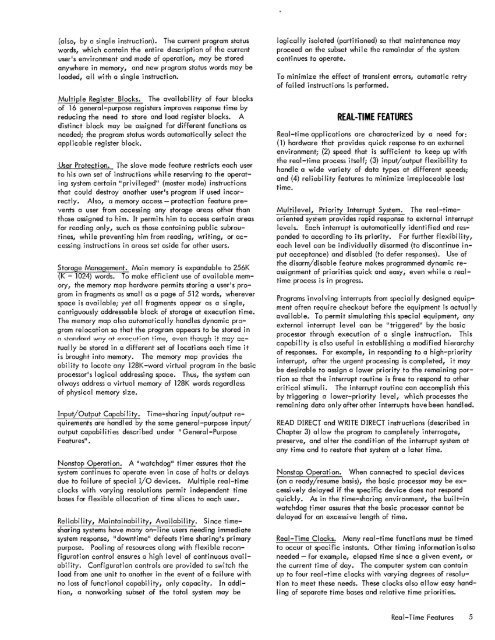1. xerox 560 computer system - The UK Mirror Service
1. xerox 560 computer system - The UK Mirror Service
1. xerox 560 computer system - The UK Mirror Service
Create successful ePaper yourself
Turn your PDF publications into a flip-book with our unique Google optimized e-Paper software.
(also, by a single instruction). <strong>The</strong> current program statuswords, which contain the entire description of the currentuser's environment and mode of operation, may be storedanywhere in memory, and new program status words may beloaded, all with a single instruction.Multiple Register Blocks. <strong>The</strong> availability of four blocksof 16 general-purpose registers improves response time byreducing the need to store and load register blocks. Adistinct block may be assigned for different functions asneeded; the program status words automatically select theapplicable register block.User Protection. <strong>The</strong> slave mode feature restricts each userto his own set of instructions while reserving to the operating<strong>system</strong> certain "privileged" (master mode) instructionsthat could destroy another user's program if used incorrectly.Also, a memory access - protection feature preventsa user from accessi ng any storage areas other thanthose assigned to him. It permits him to access certain areasfor reading only, such as those containing publ ic subroutines,while preventing him from reading, writing, or accessinginstructions in areas set aside for other users.Storage Management. Main memory is expandable to 256K(K = 1024) words. To make efficient use of available memory,the memory map hardware permits storing a user's programin fragments as sma II as a page of 512 words, whereverspace is avai lable; yet all fragments appear as a single,contiguously addressable block of storage at execution time.<strong>The</strong> memory map also automatically handles dynamic programrelocation so that the program appears to be stored inn dnnrlrlrt"l v.i0}' 0t ~X~ClJt!0!",! t!!'!'!e, e'!e!"! th0~gh it !'!'!cy cctuallybe stored in a different set of locations each time itis brought into memory. <strong>The</strong> memory map provides theabi I ity to locate any 128K-word virtual program in the basicprocessor's logical addressing space. Thus, the <strong>system</strong> canalways address a virtual memory of 128K words regardlessof physical memory size.Input/Output Capability. Time-sharing input/output requirementsare handled by the same general-purpose input/output capabi I i ti es descri bed under II Genera I-PurposeFeatures".Nonstop Operation. A "watchdog" timer assures that the<strong>system</strong> continues to operate even in case of halts or delaysdue to fai lure of special I/O devices. Multiple real-timeclocks with varying resolutions permit independent timebases for flexible allocation of time slices to each user.Reliability, Maintainability, Availability. Since timesharing<strong>system</strong>s have many on-line users needing immediate<strong>system</strong> response, "downtime" defeats time sharing's primarypurpose. Pool i ng of resources a long wi th fl exi bl e reconfigurationcontrol ensures a high level of continuous availability.Configuration controls are provided to switch theload from one unit to another in the event of a failure withno loss of functional capability, only capacity. In addition,a nonworking subset of the total <strong>system</strong> may belogically isolated (partitioned) so that maintenance mayproceed on the subset while the remainder of the <strong>system</strong>conti nues to operate.To minimize the effect of transient errors, automatic retryof fa i led instructions is performed.REAL-TIME FEATURESReal-time applications are characterized by a need for:(1) hardware that provides quick response to an externalenvironment; (2) speed that is sufficient to keep up withthe real-time process itself; (3) input/output flexibility tohandle a wide variety of data types at different speeds;and (4) reliabi lity features to minimize irreplaceable losttime.Multilevel, Priority Interrupt System. <strong>The</strong> real-timeoriented <strong>system</strong> provi des rapi d response to external interruptlevels. Each interrupt is automatically identified and respondedto according to its priority. For further flexibi lity,each level can be individually disarmed (to discontinue inputacceptance) and disabled (to defer responses). Use ofthe disarm/disable feature makes programmed dynamic reassignmentof priorities quick and easy, even while a realtime process is in progress.Programs involving interrupts from specially designed equipmentoften require checkout before the equipment is actuallyavai lable. To permit simulating this special equipment, anyexternal interrupt level can be "triggered" by the basicprocessor through execution of a single instruction. Thiscapability is also useful in establishing a modified hierarchyof responses. For example, in responding to a high-priorityinterrupt, after the urgent processing is completed, it maybe desirable to assign a lower priority to the remaining portionso that the interrupt routine is free to respond to othercritical stimul i. <strong>The</strong> interrupt routine can accomplish thisby triggering a lower-priority level, which processes theremaining data only after other interrupts have been handled.READ DIRECT and WRITE DIRECT instructions (described inChapter 3) allow the program to completely interrogate,preserve, and a I ter the conditi on of the interrupt <strong>system</strong> atany time and to restore that <strong>system</strong> at a later time.Nonstop Operation. When connected to special devices(on a ready/resume basis), the basic processor may be excessivelydelayed if the specific device does not respondquickly. As in the time-sharing environment, the built-inwatchdog timer assures that the basic processor cannot bedelayed for an excessive length of time.Real-Time Clocks. Many real-time functions must be timedto occur at specific instants. Other timing information isalsoneeded - for example, elapsed time since a given event, orthe current time of day. <strong>The</strong> <strong>computer</strong> <strong>system</strong> can containup to four real-time clocks with varying degrees of resolution to meet these needs. <strong>The</strong>se clocks a I so a II ow easy handlingof separate time bases and relative time priorities.Real-Time Features 5
















